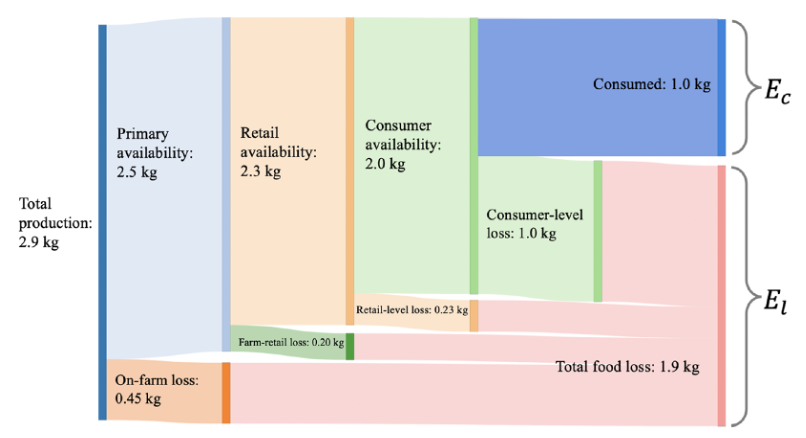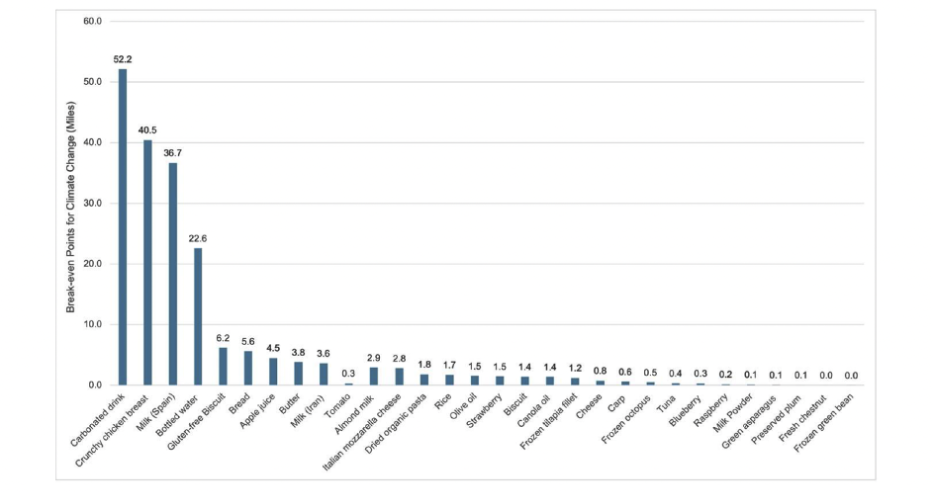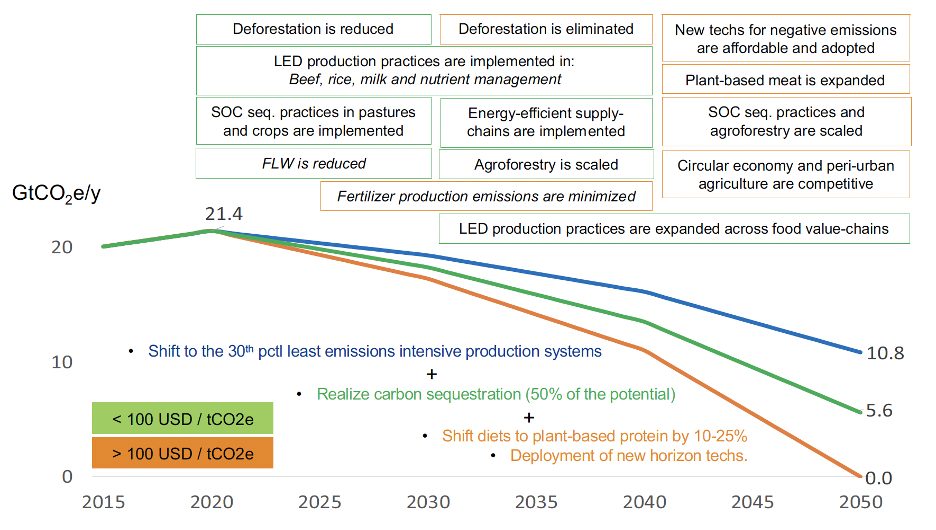Power Innovation companions with the impartial nonprofit Aspen International Exchange Institute (AGCI) to supply local weather and effort examine updates. The examine synopsis underneath comes from AGCI Program Director Emily Jack-Scott and AGCI Program Affiliate Devan Crane. A complete checklist of AGCIâs updates masking contemporary local weather trade and blank power pathways examine is to be had on-line at https://www.agci.org/answers/quarterly-research-reviews.
Contemporary examine highlights how 65 p.c of meals formula emissions come from the manufacturing, processing, shipping, and intake of simply 4 emissions-intensive meals: pork, milk, rice, and corn (maize).
Confronted with excessive meals costs and steady disruptions to offer chains, many families in the USA are appreciating afresh what it takes to develop, collect, and ship the meals they eat each day. However what the typical shopper won’t absolutely acknowledge is the level to which their on a regular basis meals possible choices give a contribution to emissions of greenhouse gasses (GHGs). The meals formula as an entire accounts for a whopping 35 p.c of worldwide emissions, and shopper selections like vitamin and buying groceries patterns very much affect the ones emissions.

Rising examine is starting to make clear movements that customers and manufacturers can take to scale back meals formula affects at the local weather and transfer towards a ânet-zeroâ formula through which all emissions produced are offset via sequestration processes.
Emissions from farm to desk to landfill
Emissions are generated at each and every level of the meals formula, from the manufacturing of meals on farms to move and refrigeration to processing and packaging to shopper nutritional possible choices and, in the long run, to meals waste. Seventy p.c of general meals formula emissions come from land-use trade. As an example, when a woodlandâwhich naturally absorbs and retail outlets carbon dioxide as bushes developâis logged and transformed to grazing or agricultural land, GHGs are launched as bushes decompose. Further emissions consequence from tilling soils and making use of fertilizers for agricultural manufacturing. The remainder meals formula emissions are due to different phases reminiscent of shipping, packaging, and waste. With emerging populations and rising appetites for emissions-intensive meals, emissions are projected to extend 50 p.c via 2050 below business-as-usual prerequisites.
In a 2022 paper printed in Nature Clinical Studies, Ciniro Costa, Jr., and co-workers spotlight how 65 p.c of meals formula emissions come from the manufacturing, processing, shipping, and intake of simply 4 foodstuffs: pork, milk, rice, and corn (maize). Through that specialize in those emissions-intensive meals, the authors modeled 60 eventualities of interventions that might scale back emissions around the international meals formula. They discovered {that a} net-zero meals formula may well be accomplished via in style adoption of system-wide potency enhancements, shifts towards plant-forward diets, nature-based sequestration, and adoption of rising applied sciences.
Lots of the low-emissions interventions analyzed (70 p.c) make the most of current expertise and applied sciences: lowering deforestation, higher managing manure, making improvements to feed and breeding (which will scale back methane emissions from farm animals), lowering nitrogen fertilizer overuse and runoff, and adopting renewable power and effort potency. Sequestration approaches reminiscent of agroforestry and low- or no-till agriculture even have vital co-benefits reminiscent of soil and water conservation. Higher adoption of low-emissions practices manner much less reliance on sequestration might be wanted to succeed in a net-zero emissions meals formula.
Emissions from meals loss and waste
Lowering meals loss and waste is an extra observe that Costa and co-workers emphasize. Meals loss and waste by myself account for 8-10 p.c of all international GHG emissions (Ribbers et al., 2022), with roughly 1.3 billion heaps of meals perishing every year (Ouro-Salim and Guarieri, 2021). Meals loss and meals waste are continuously thought to be in tandem, however they’re distinct problems. Meals loss usually refers to lack of fit for human consumption meals ahead of harvest or within the provide chain (e.g., because of incapacity to reap all of a crop ahead of it starts to rot, or deficient refrigeration right through shipping). Meals waste, against this, refers to lack of fit for human consumption meals because of shopper habits, (e.g., over-ordering at a cafe or deficient making plans that results in groceries expiring and changing into inedible) (Kumar et al., 2022).
Particularly, there are vital variations between high-income and low-income nations on the subject of meals loss and waste. In high-income nations, meals waste makes up 50 p.c of total losses, while meals waste in low-income nations accounts for simplest 5 p.c of total losses (Kumar et al., 2022). In low-income nations, meals loss is extra of an issue and usually effects from systemic demanding situations, reminiscent of loss of get admission to to non-local markets, garage, transportation, refrigeration, and harvesting era (Ouro-Salim and Guarieri, 2021). Lowering meals waste in high-income nations is in large part a voluntary act for the patron, with only a few waste-reduction enforcement insurance policies in position (Stancu and Lähteenmäki, 2022).
Meals waste too can range via form of meals, and high-nutrition meals like contemporary produce are particularly liable to waste. Qin and Horvath discovered of their 2022 learn about printed in Sources, Conservation & Recycling that within the U.S., family meals waste may also be the most important supply of meals loss emissions. When it comes to cherries, for example, excessive loss and waste just about triple emissions: for each and every kilogram (2.2 lbs) of cherries fed on via a family, every other kilogram is misplaced right through manufacturing and transit, and a 3rd kilogram is wasted post-purchase (see Determine 1).

Determine 1. âSankey diagram for the manufacturing and meals lack of one kilogram (2.2 kilos) of cherry intake. Ec covers the life-cycle emissions for fed on meals from manufacturing, packaging, transportation, and refrigeration within the truck, retail shop, and shopperâs house. El covers the cradle-to-grave emissions from meals loss.â Supply: Qin and Horvath, 2022.
Lowering meals loss and waste is a technique families and folks have the ability to noticeably scale back their local weather affect, particularly in high-income nations. So what holds us again? Why do such a lot of U.S. customers waste meals, particularly when it’s an increasing number of pricey and in some cases sporadically to be had? And what different possible choices can customers make to scale back emissions from the meals they consume?
Psychology of lowering meals waste
In a 2022 paper in Meals Coverage, co-authors Violeta Stancu and Liisa Lähteenmäki tested food-related behaviors that give a contribution to shopper meals waste, together with shopper self-identities, buying dispositions, and disgust sensitivity (how simply disgusted an individual is via a mealsâs perceived edibility). They argue that a greater figuring out of those drivers can assist tell extra focused coverage and public consciousness campaigns.
In a connected paper in International Environmental Exchange led via Daphne Ribbers, researchers investigated behavioral motivations corresponding to the patron self-identities defined via Stancu and Lähteenmäki. Whilst the 2 ideas are identical, motivation âmay also be outlined as the method that determines the ⦠route of habits, and is typically understood as the explanation why people proceed, or terminate a selected habitsâ (Ribbers et al., 2023), while self-identities consult with âbehaviors which are in keeping with ⦠the label that folks use to explain themselvesâ (Stancu and Lähteenmäki, 2022). Each research tested the environmental, ethical, monetary, and social dimensions of those drivers of habits.
Stancu and Lähteenmäki discovered that people with frugal and environmental self-identities and in older demographics have been much less prone to waste meals, while folks at risk of impulse purchasing, with excessive disgust sensitivity, and with upper earning have been much more likely to waste meals. Additionally they discovered that in-store advertising and retail stimuli can affect folks to buy greater than was once deliberate (impulse purchasing), resulting in meals waste. Those elements level to a possibility for consciousness campaigns that may assist customers prohibit impulse purchasing and undertake aware buying groceries behaviors. Shops may be held responsible to scale back meals waste via the use of advertising methods that donât prey on impulsive dispositions.
People who are extra simply disgusted via perceived meals imperfections have been additionally discovered to be extra wasteful. The belief that meals was once inedible was once in large part influenced via false impression the average food-labeling formula of âbest-byâ and âuse-byâ dates. âAbsolute best-byâ dates relate to meals high quality, while âuse-byâ dates relate to meals protection. Checking edibility via scent or style when a meals is previous its labeling date, fairly than robotically tossing meals, may just scale back meals waste. Training campaigns excited by expanding meals labeling wisdom may just assist reduce confusion and scale back meals being thrown out in advance.
Ribbers and co-workers discovered that customers who waste much less meals have been considerably motivated via environmental and ethical elements: consciousness of environmental affects or feeling guilt about losing meals. Apparently, monetary and social motivations (frugality or the fear of showing wasteful to others, respectively) weren’t vital motivations to keep away from meals waste. The authors warning that there is also cases through which monetary motivations are vital and is also intertwined with environmental and ethical motivations. As in Stancu and Lähteenmäkiâs learn about, Ribbers discovered that older folks usually waste much less meals.
Each papers additionally famous that long term examine will have to focal point on behaviors and culturally particular motivations for extra focused answers and coverage.
Particular person movements to scale back meals emissions
Along with lowering meals waste, person customers have alternatives to restrict their meals emissions footprint via lowering superfluous packaging and via embracing nutritional shifts.
Frequently customers simplest imagine the meals waste they are able to bodily see and contact, (e.g., scraping a plate into the trash on the finish of a meal or forgetting a leftover field the eating place packed up). If truth be told, customers give a contribution to a whole waste cycle that stems from the power and water used right through manufacturing, harvest, subject matter extraction, packaging advent, packaging, transportation, garage, intake, and wastage/misuse (see determine 2). Shoppers will have to additionally imagine the end-of-life penalties of waste: air pollution, millennia-long breakdown instances, and overflowing landfills (Qin and Horvath, 2022).

Determine 2. Waft diagram of the meals lifestyles cycle â encompassing an summary of the processes for inputs, alternatives for waste, and outputs. This cycle illuminates what is probably not visual to the top shopper. Supply: Qin and Horvath 2022.
For example, use of plastic packaging has higher sharply in contemporary a long time, from 2 million heaps in 1950 to 381 million heaps in 2015. Some packaging is helping scale back waste via extending the shelf lifetime of meals and protective them right through shipping, however no longer all packaging has the similar emissions. In a 2022 research in Sources, Conservation and Recycling, co-authors Mengqing Kan and Shelie Miller targeted at the environmental affects of plastic packaging throughout a mealsâs complete lifecycle in addition to its annual intake. The authors then in comparison the power used over more than a few mealsâ lifestyles cycles to an identical car emissions to position the consequences into extra acquainted phrases for non-scientists.

Determine 3. Translating the intake affects of sure meals pieces into an identical miles of auto commute lets in folks to position their very own intake conduct in point of view with the standard day by day job of using. The graph displays âbreak- even miles at which local weather trade of meals packaging equals local weather trade of auto transportation.â Carbonated drinks being the largest culprit within the checklist of meals studied, displays that the an identical affect of a three hundred and sixty five daysâs intake in keeping with capita is the same as 52.2 miles of GHG emissions (84 kilometers) which is just about double of the day by day reasonable of 30 miles (48.3 kilometers) traveled via america motive force. Supply: Kan and Miller 2022
Kan and Miller discovered that, in keeping with reasonable US in keeping with capita annual intake charges, whilst emissions from meals packaging are vital, for many merchandise they faded compared to in keeping with capita emissions from different on a regular basis actions like using. Lots of the meals packaging within the learn about had annual in keeping with capita emissions an identical to lower than an afternoon of using (the typical individual within the U.S. drives 30 miles in keeping with day). Notable exceptions incorporated carbonated drinks, crunchy rooster breast, sure varieties of milk, and bottled water. The authors additionally be aware vital co-benefits to restricting packaging, reminiscent of lowering the environmental affects of extraction and disposal, particularly for merchandise disposed of improperly.
Nutritional shifts are every other vital approach customers can prohibit their non-public meals emissions. Nearly all eventualities that time to a net-zero meals formula depend on customers transferring to a extra plant-forward vitamin, particularly in high-income nations. Call for for farm animals merchandise like pork and milk will have to be lowered via 10-25 p.c to score low-emissions or net-zero targets (Costa et al., 2022).
Farm animals give a contribution to meals formula emissions throughout the meals they eat and excrete, in addition to the water and land wanted for his or her manufacturing. In a 2022 paper printed within the Complaints of the Nationwide Academy of Sciences, Claudia Arndt and co-workers studied a number of techniques to scale back methane gasoline emissions from farm animals with out lowering productiveness via converting their vitamin formulations and grazing practices along breeding and genetic requirements. A number of combos of mitigation methods even higher animal manufacturing. The learn about discovered that adoption of any any such methods by myself would no longer reach international emissions discount targets via 2030, however adopting more than one wonderful methods would succeed in goal discounts.
Lowering emissions on the farm animals manufacturing level is important to total discount of meals system-related GHG emissions. However in the long run, shopper call for for farm animals merchandise will have to be curbed to decrease total emissions. Construction of latest plant proteins is one solution to shift shopper diets to meat choices and meal substitutions (Costa et al., 2022).
Past person movements
 Whilst person customers have a substantial amount of company to curb emissions via lowering meals waste and packaging and opting for extra plant-forward diets, governments and buyers will have to additionally design insurance policies and monetary mechanisms to reduce emissions during the meals formula.
Round financial system practices can assist redirect meals from landfills via donating still-good meals for human and animal intake or channeling inedible meals to composting, bio merchandise, and sewage/wastewater remedy amenities (Ouro-Salim and Guarieri, 2021).
Of their eventualities to succeed in a net-zero emissions meals formula, Costa and co-workers discovered that whilst maximum low-emissions interventions have been in keeping with current applied sciences, simplest about 50 p.c could be charge wonderful at a value lower than $100/ton of carbon dioxide. They lay out the next timeline of movements in all probability to succeed in net-zero emissions whilst expanding manufacturing of meals for rising populations, favoring essentially the most cost-effective interventions within the close to long term:

Determine 4. âRoadmap for meals programs web 0 emissions via 2050.â The roadmap displays how the end result of more than a few tactics can result in a discount of GHG emissions to a impartial or net-zero state via 2050. Supply: Costa et al. 2022
Governance and finance mechanisms might be had to scale back deforestation and emissions from high-emitting vegetation and farm animals and advertise sequestration on the scale required to scale back international meals emissions. For methods which are already charge wonderful, conventional financial institution loans will have to be explored. To advertise practices which are much less charge wonderful, public bucks may also be strategically invested in personal ventures to scale back preliminary dangers of early adoption and scale up carbon markets. The authors additionally highlight the will for long-term philanthropic and affected person personal capital investments in high-risk rising applied sciences.